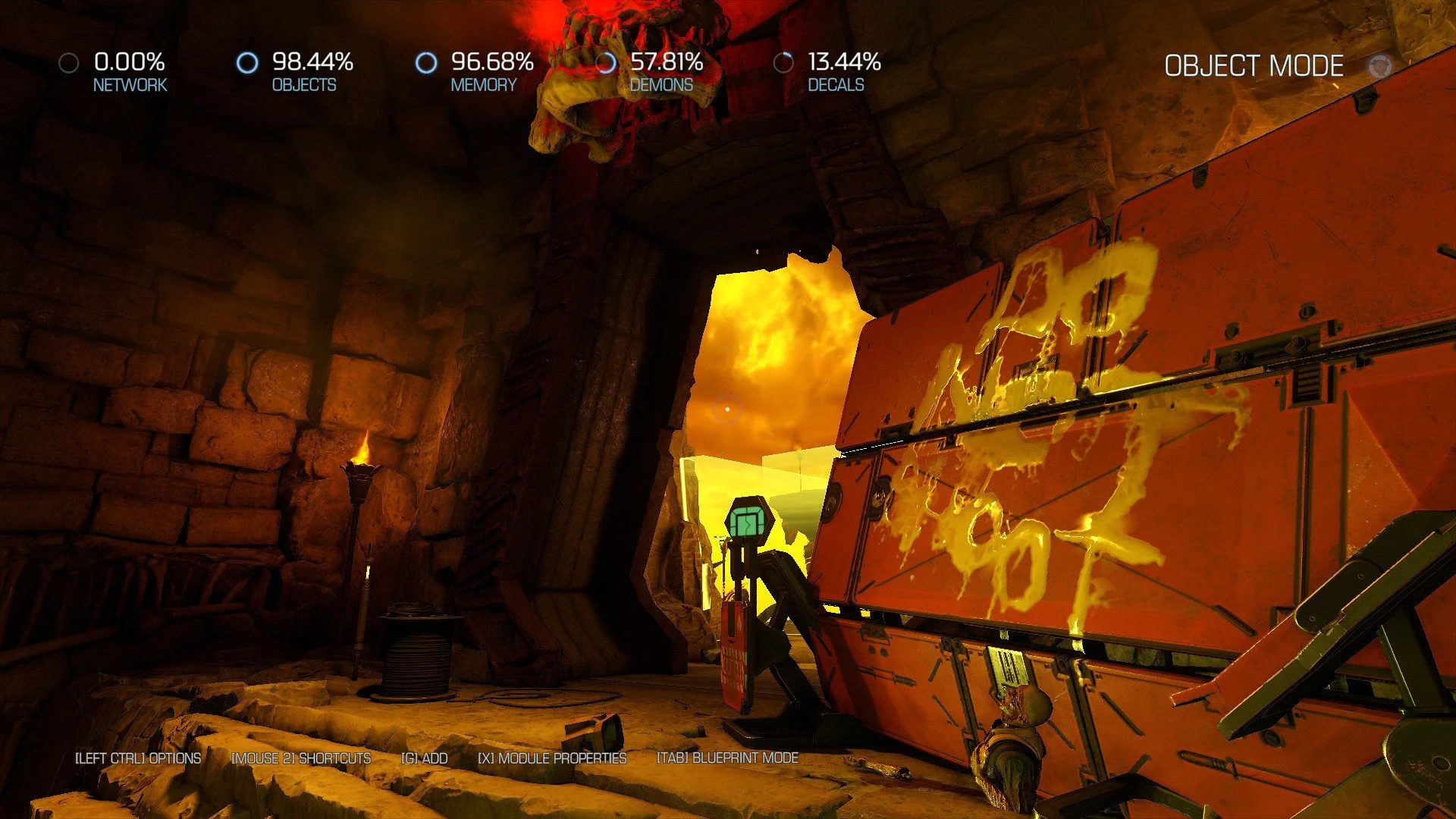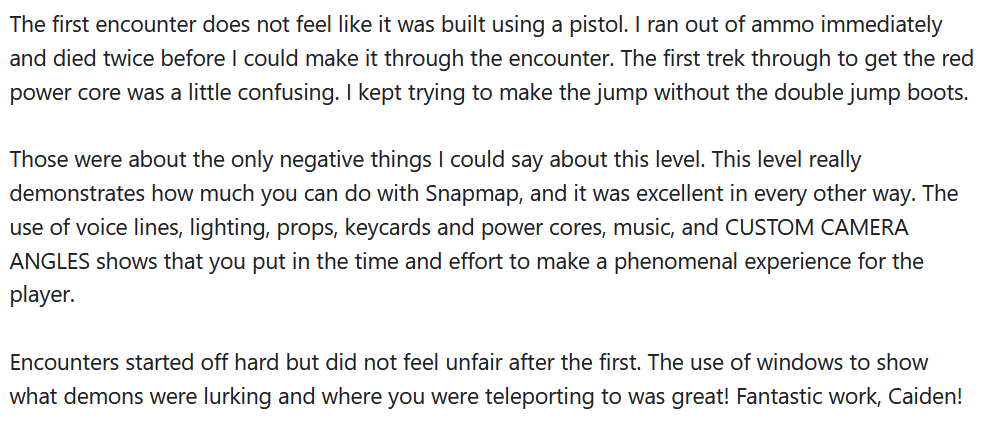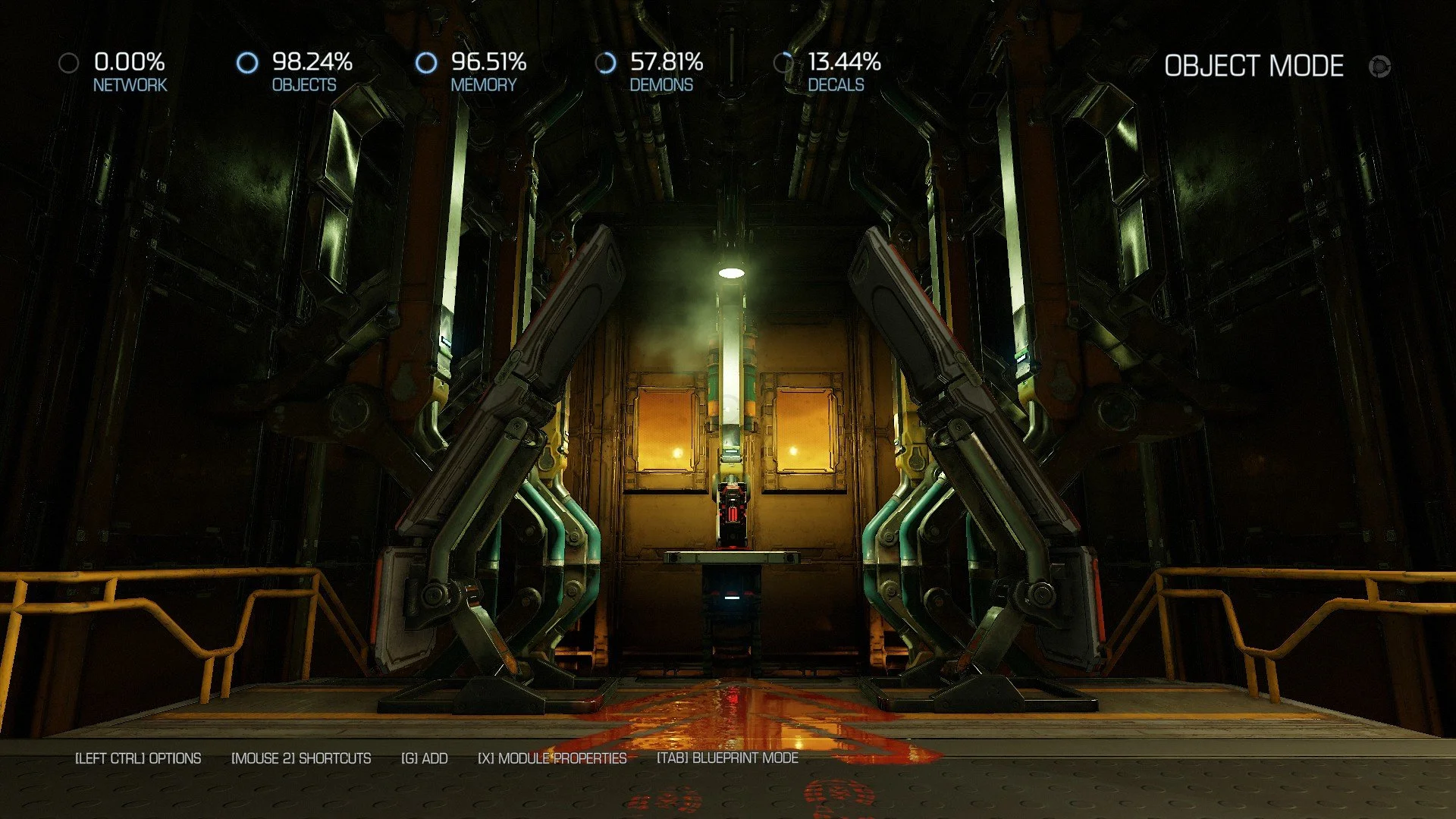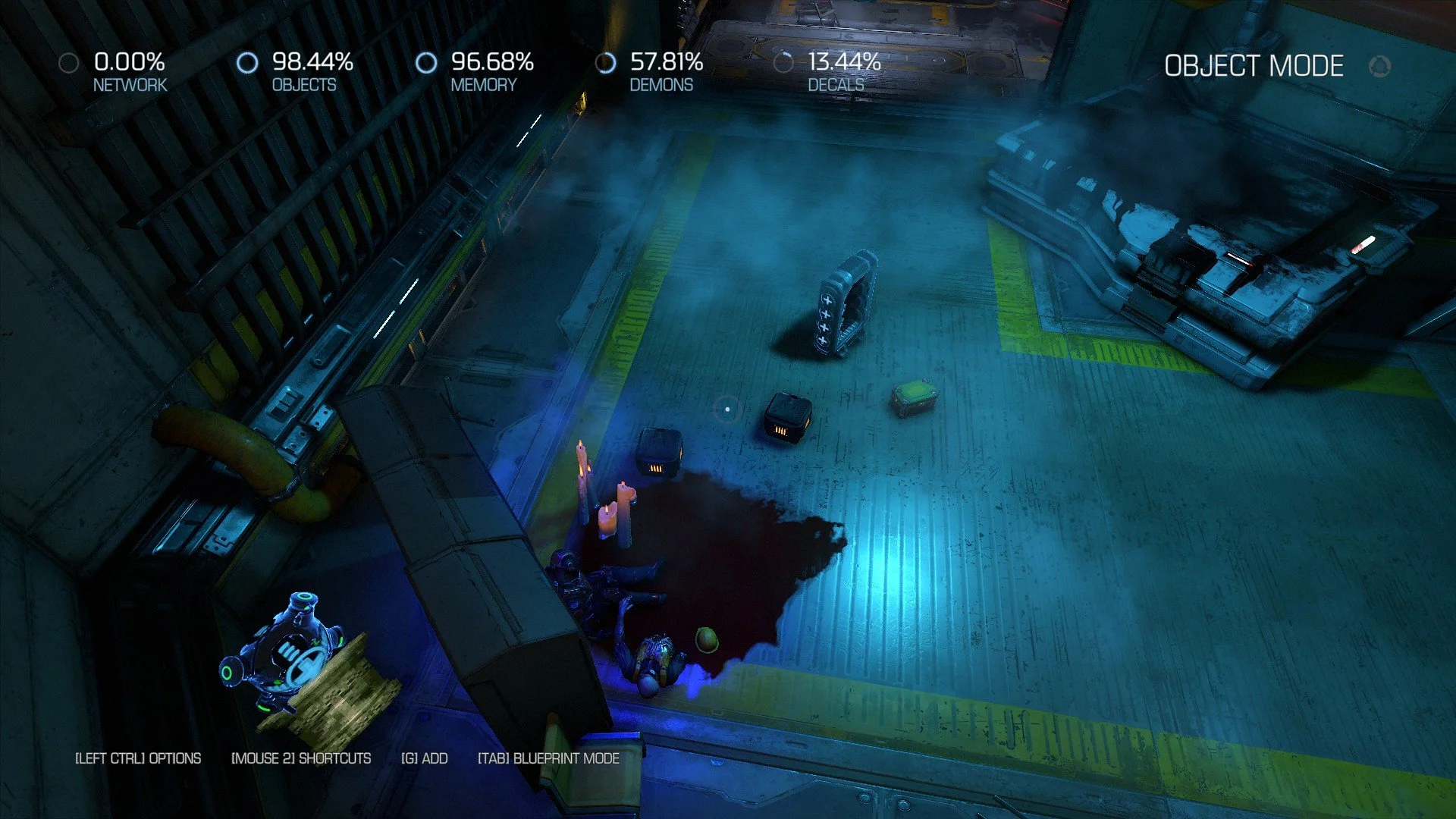DOOM (2016) Level
Level Code
6BV9 8FXY
Results: Planned, designed, and iterated a level made inside DOOM (2016)’s in-engine editor: SnapMap
Team Size: Solo
Development Period: ~3 months
Tools: SnapMap
Side-to-Side Comparison
Look at the differences made between the original version and the REDUX version
Original Version
REDUX Version
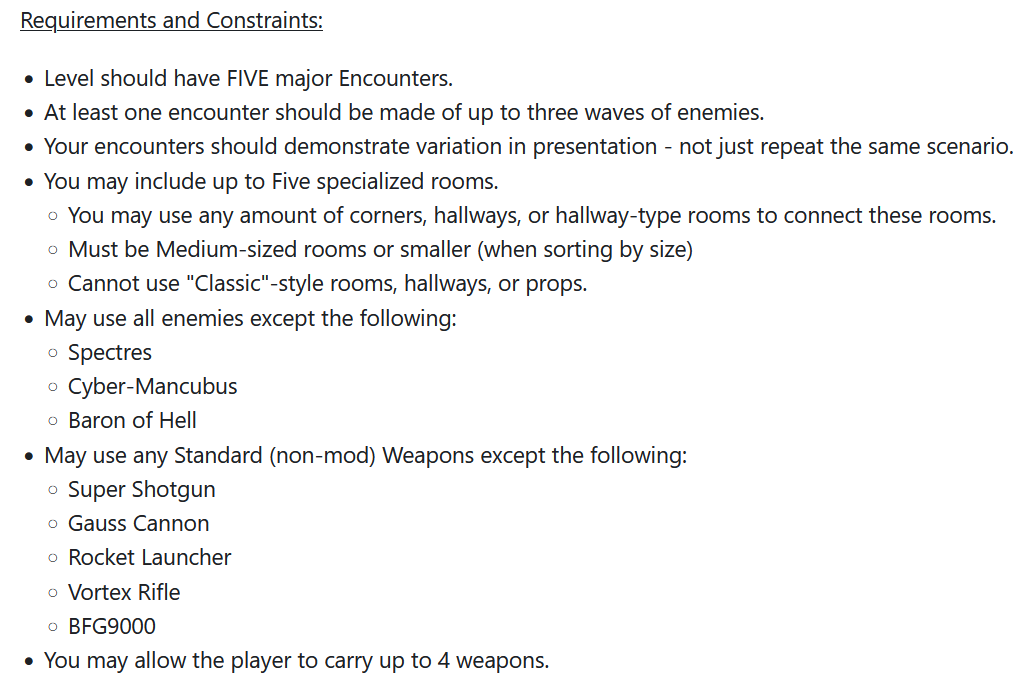
Project Goals
The brief for the project was simple enough. I needed to essentially make sure the level had some standout moments of combat along with a few rooms that served a specific purpose.
There were, of course, some limitations for combat itself such as some of the stronger enemies being off-limits and weapon mods and weapon count limits. Which is reasonable.
From this simple brief alone, I deduced that this level would serve as a sort of “beginning-to-middle of the game” level for a theoretical DOOM game this would be in. This simple frame of mind helped my conceptualize exactly the scale/scope this level would take once I started planning it.
Why Use DOOM’s SnapMap?
I chose to work in DOOM’s SnapMap editor because it would challenge me to learn a new tool for creating levels I hadn’t used before.
Additionally, having previous experiences with DOOM excited me to try my hand at contributing my own to this legendary series with my spin and see how difficult making an experience for this series really is.
Planning & Sketching
I knew my ambitions would likely be too big for the project brief. So my planning was to get my expectations in check and find what the overall direction of the level will be to fit the project time versus my ambitions—not to mention any time taken to learn the tool itself.
I knew I wanted a sort of three-act structure. The introduction, the rising action/journey, then the climax. So I settled on an objective to make this more explicit. This took the form of the red, blue, and green power cores. However, where I’d say each “act” starts and begins isn’t necessarily when they are collected. I can clear that up soon.
Setting the Scene
Looking into my design, learning the tools, and considering the props at my disposal, I concocted a “story” for this level that I’d be able to build up with environmental details throughout the spaces. This story informed a lot of my design choices for the atmosphere, prop choices, and even VFX for certain elements!
In short, this level will be taking place inside a UAC facility that houses a powerful energy core that serves as the level’s “Hub”. However, this facility requires resources from Hell to operate. So naturally, there’s a portal to hell within the facility for brave explorers to venture into Hell for UAC. Unfortunately, they were not ready for the hoards of horrors that’d jump at the opportunity to escape into the facility—killing every living thing in their sight. It’s up to you to recover the backup power cores to fix the energy core of the facility and progress through the theoretical DOOM game this level would be a part of.
Editor Research
At this point, I wanted to dive into SnapMap, learn how this tool works, and see if I could develop my own flair with it.
To do this I took the time to use the built-in examples they included to show how specific functions work. I also made heavy use of community-made videos on achieving more advanced techniques to achieve the ambitions for the level I’m making.
I thought this process would have been simple but it seems this tool isn’t as well documented or supported as I assumed but I took it as a healthy challenge to learn how most of this works from my own observations.
Using Research to Take it to the Next Level
Hands down the most useful and impactful feature I learned in my research phase was its audio features. This feature allowed me to use pre-recorded voice lines included in the game of various characters and play them within the level either in 2D or 3D space. I feel that this elevated my level from a string of rooms to more of a complete experience. This allowed me to tell the story of the level in a way that was more true to the source material this level was made inside (DOOM).
Additionally, it allowed me to use it as guidance wherever it was needed or use to elevate the environment the player was in even in the subtlest of ways.
I also used the extensive VFX in the tool to create my immersive areas in the level as well as created scripted sequences to make the experience feel more dynamic for the player.
Act 1: The Introduction
This first part of the level starts at the player spawn up until the player walks through the door for the red power core. The core moments for this section include establishing the basic concepts for the level such as…
Using the pistol weapon’s charge
Introducing the main objective
Introducing the basic enemy types
I made use of custom HUD elements to tell the player critical information to learn for their success in the level’s coming challenges. I was also sure to give them the ability to practice using the pistol before they were able to make progress.
Using the aforementioned voice lines, I was able to introduce the objective in a clear manner and I had also learned how to manipulate the camera in order to make it as clear as I possibly could and more dynamic as well.
Act 2: The Rising Action / the Journey
This part is defined by the area just after the door to the red power core branch until the player collects the keycard in the long straight hallway. This is about the longest part of the level naturally as it’s the bulk of the experience and has the most concepts within it.
Introduce the more difficult enemy types
Introducing Double-jumping
Practicing basic puzzle-solving
Introduce a new weapon
I also made a conscious effort to try and make introductions to these concepts and had the time for them to be taught without much stress while also keeping the momentum going.
This act also has 3 scripted fights the player will be tasked with going through—each of increasing difficulty. The first being a basic arena fight with low-level enemies, the second is a lower enemy count however with a tight space, and the third is an arena fight with more difficult enemies.
I designed this area slightly as if it were a Metroidvania in the sense that the main objective isn’t exactly at the “end” of the section but is simply needing the necessary ability to reach it.
Act 3: The Climax
The final leg of the journey included the most difficult fights of the level including a boss battle to cap it off. Originally, I wanted this section to be included in Act 2 but as I realized three branches of these sizes were too much for the allotted playtime, I decided to merge the hell branch and the UAC Labs branch from my planning sketches into one branch where the labs were taken over by demons and already transforming the space.
This area contains almost exclusively combat. It’s a gauntlet to rip and tear through with the abilities you’ve acquired so far. The player is jumped by a Pinky, then has to fight through a zigzagging lab with bigger baddies, and then face the boss Mancubus at the end guarding the final power core.
Playtesting & Feedback Round One
The feedback I received for the level was very positive! My effort to stay within the brief paid off as well as the extra effort to make the experience engaging.
The constructive feedback I received from multiple playtesters stemmed from some confusing guidance at times and some difficulty scaling near the very beginning of the level.
My observations in playtesting showed me that players weren’t reading the captioned text telling them how to charge the pistol and instead using the considerably weaker basic shot which made the encounters much more difficult than intended.
With this feedback, I sat on these words and started making a new version of the level to address the issues as best I could—I called this new version a “Redux”.
Act 1 REDUX: Introduction
I’ll speak on the changes made to Act 1. A bigger issue I saw was that players weren’t learning that they can charge the pistol’s shot which in turn made the early encounters more difficult until you got the shotgun.
To find out what was happening I saw that playtesters were too busy focusing on the environment and the enemy about to run at them to notice that there’s text at the bottom of the screen telling them how to charge the shot—which was incredibly fair.
To mitigate this, I added a delay before the enemy spawned for the HUD to display an even more explicit message in the middle of the screen telling the player how to charge the pistol’s shot before combat. It was a simple change but I think this was a critical change that’ll help with tutorialization and difficulty.
Act 2 REDUX: the Rising Action / the Journey
This area needed some guidance. So what I did was add some scripted moments for points in the level players often got stuck at. Notably, when the first arena fight was over, they’d attempt to get to the red power core without the boots for too much time and expected the answer to be in the same room seemingly without knowing the door was there for progression.
At that point, I added a trigger that played voice lines indicating another plan was required and wanted to encourage the player to find another way to get to the power core. Once going through the door to the next room, I wanted to encourage the player they were going the right way by playing some more voice lines indicating a piece of critical equipment is nearby they must find.
I also added a spot after the double-jump boots were collected to have the player practice double-jumping. I saw playtesters never used the double-jump after the required use of them for the red power core and I deduced it was because of the lack of tutorialization. This new chance to practice using them made me see an increased use of them after collecting the power core.
Additionally, a whole load of environmental props was added along with a total redesign of the first arena fight area! Players seemed to stay pretty static in the room so I wanted to encourage more of a dynamic area to jump around in to find the enemies around the corner.
Also, the entrance to the blue power core area received a major redesign to be much more atmospheric with dark lighting and a retheme to a security checkpoint instead of being an innocuous panel to open the door.
Act 3 REDUX: The Climax & Twist?
This leg of the level received an incredible overhaul! With more time to work on the level on my hands, I wanted to go back and revive the idea of Hell being a major environment at the level. However, instead of making an entirely new area for the level and dramatically extending playtime, I used the idea of the “taken over” labs to the extreme and made this area a mixed-area of lab, to hell, to lab again making it an incredibly dynamic part of the level with high action!
I made this change because the zigzag nature of the original area flowed in a way I found very unsatisfactory and at times even confusing. Players weren’t interacting with the space well and it didn’t seem fun either. So I wanted to change the experience wholesale.
This new version adds a big twist after collecting the green power core where you are turned into a Revenant demon! After a short challenge using its jetpack abilities and gun, you are tasked to survive a timed combat challenge against a hoard of difficult demons while electrical hazards litter the stage. While this sounds difficult, this part is also meant to make you feel powerful as you blast demons to a pulp.
After surviving the hoard, you are fed into the same boss fight in human form as the original version for the final fight for the final core.
Playtesting & Feedback Round Two
Feedback for this REDUX version of the level was staggeringly positive! While I still observed the tiniest moments of guidance confusion, it was leaps and bounds better than it was before. All, my playtesters had little to no negative comments about the level and in fact picked little moments out to me they really enjoyed.
Final Thoughts
This project took quite a while to learn, build-out, and iterate on, but I would be lying if I said I didn’t enjoy every moment of working on it. All throughout I was incredibly passionate for the work I was doing and was always considering and looking forward to how players will interact with the experience I was creating.
Even if the project was very well received by both playtesters and instructors, I feel like I could keep working on this level forever. Even now I think of ways it could be even better—especially in the guidance department. I feel as though guidance is one of those things you could work on forever balancing explicit with clever guidance.
That’s what I feel I’ve learned most from this project in general, that no matter how clever you feel your guidance is, if it isn’t explicit, it’s going to be missed. So don’t get too cute with it.




